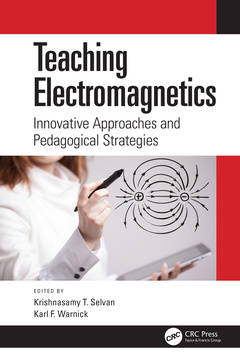Teaching Electromagnetics Innovative Approaches and Pedagogical Strategies
Coordonnateurs : Selvan Krishnasamy T., Warnick Karl F.

Teaching Electromagnetics: Innovative Approaches and Pedagogical Strategies is a guide for educators addressing course content and pedagogical methods primarily at the undergraduate level in electromagnetic theory and its applications. Topics include teaching methods, lab experiences and hands-on learning, and course structures that help teachers respond effectively to trends in learning styles and evolving engineering curricula. The book grapples with issues related to the recent worldwide shift to remote teaching.
Each chapter begins with a high-level consideration of the topic, reviews previous work and publications, and gives the reader a broad picture of the topic before delving into details. Chapters include specific guidance for those who want to implement the methods and assessment results and evaluation of the effectiveness of the methods. Respecting the limited time available to the average teacher to try new methods, the chapters focus on why an instructor should adopt the methods proposed in it. Topics include virtual laboratories, computer-assisted learning, and MATLAB® tools. The authors also review flipped classrooms and online teaching methods that support remote teaching and learning. The end result should be an impact on the reader represented by improvements to his or her practical teaching methods and curricular approach to electromagnetics education. The book is intended for electrical engineering professors, students, lab instructors, and practicing engineers with an interest in teaching and learning. In summary, this book:
- Surveys methods and tools for teaching the foundations of wireless communications and electromagnetic theory
- Presents practical experience and best practices for topical coverage, course sequencing, and content
- Covers virtual laboratories, computer-assisted learning, and MATLAB tools
- Reviews flipped classroom and online teaching methods that support remote teaching and learning
- Helps instructors in RF systems, field theory, and wireless communications bring their teaching practice up to date
Dr. Krishnasamy T. Selvan is Professor in the Department of Electronics & Communication Engineering, SSN College of Engineering, since June 2012.
Dr. Karl F. Warnick is Professor in the Department of Electrical and Computer Engineering at BYU.
1. Introduction.
2.Teaching and Learning Electromagnetics in 2020.
3. An Experiential Learning Approach in Electromagnetics Education.
4. Teaching and Learning Electromagnetics through MATLAB® Programming of Electromagnetic Fields.
5. Interactive Computational Tools for Electromagnetics Education Enhancement.
6. Computational Electromagnetics and Mobile Apps For Electromagnetics Education.
7. Teaching Electromagnetic Field Theory Using Differential Forms.
8. Maxwell’s Displacement Current: A Teaching Approach Infusing Ideas of Innovation and Creativity.
9. Teaching Electromagnetic Waves to Electrical Engineering Students: An Abridged Approach.
10. Taking Electromagnetics Beyond Electrical and Electronics Engineering.
11. HyFlex Flipping: Combining In-Person and On-Line Teaching for the Flexible Generation.
12. Learning and Teaching in a Time of Pandemic.
13. Conclusion and Outlook.
Dr. Krishnasamy T. Selvan is Professor in the Department of Electronics & Communication Engineering, SSN College of Engineering, since June 2012.
Dr. Karl F. Warnick is Professor in the Department of Electrical and Computer Engineering at BYU.
Date de parution : 06-2021
15.6x23.4 cm
Date de parution : 06-2021
15.6x23.4 cm
Thèmes de Teaching Electromagnetics :
Mots-clés :
computational electromagnetics; COVID-19; Practicing engineers; electrical and electronics engineering; Teaching methods; electromagnetic field theory; Pedagogical strategies; electromagnetic waves; Electromagnetics education; electromagnetics education enhancement; Electromagnetic theory; flipped teaching model; HyFlex course; interactive computational tools; MATLAB; Maxwell’s displacement current; mobile apps; on-line teaching; virtual learning; IEEE Antenna; Student Instructor Contact Time; Anonymous Student Feedback; Em Theory; Practical Laboratory Sessions; RF Signal Generator; Improve Knowledge Retention; HFF; F2F Students; SMA Connector; Experiential Learning Approach; In-person Labs; FDTD Method; Exterior Derivative; Learning Cycle; Displacement Current; Plane Wave Reflection; Refractivity Profile; Blended Learning; Flipped Class; Coupled Transmission Lines; Coulomb Gauge; Standard Simulation Software; Uniform Plane Wave



